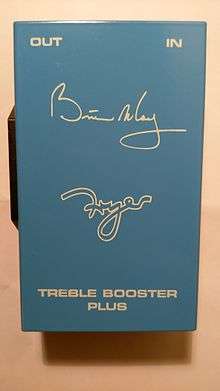Treble booster

A treble booster is an effects unit used by guitarists to boost volume and especially the high end of their tonal spectrum, and was popular mostly during the 1960s.
Popularized by guitarists such as Tony Iommi,[1] Ritchie Blackmore, Rory Gallagher, Brian May, and Marc Bolan,[2][3] treble boosters were used to overdrive amplifiers (mostly dark sounding, British tube models such as Marshall Bluesbreakers and Vox AC30s) in order to create a more distorted yet focused sound. They came up in the mid-1960s. By the 1980s they had fallen out of use. Guitarists used overdrive pedals instead, in a similar fashion. But the circuit and its derivatives have experienced a great revival in the 21st century, thanks to the many boutique builders who have rediscovered the circuit. While IC-based overdrive pedals remain far more popular than treble boosters, some players prefer the less compressed and more dynamic response of Rangemaster-family boosters.

Dallas Rangemaster
One of the earliest treble booster was the Dallas Rangemaster. Unlike most of today's clones, the original Rangemaster was not a pedal, but a box meant to be placed on top of the amplifier. The circuit makes use of a single OC71 or OC44 germanium transistor.
The Rangemaster has also been used extensively by Brian May, Tony Iommi, Marc Bolan and Rory Gallagher.
Hornby Skewes
Just like the Dallas Rangemaster, the Hornby Skewes treble booster was an amp-top unit.
While early Hornby Skewes Treble Booster units used a germanium transistor, the later, better-known version features a silicon transistor. Rumours about a JFET version may source from a misread part number.[4]
It's prominently featured on Jethro Tull's Aqualung album.[5]
It was also used by Ritchie Blackmore during the 1960s until 1974, when it was replaced by a modified AIWA tape recorder.
Hornby Skewes also made a bass booster[6] and a treble and bass booster, the Hornby Selectatone T.B.2.[7]
Vox
Vox made a variety of boosters that were meant to be plugged directly into amps or guitars, including the model V806 Treble Booster.[8] Roger McGuinn installed one into his Rickenbacker guitar in the 1960s.[9]
Electro-Harmonix
Electro-Harmonix used to make treble boosters in two different enclosures. The Screaming Bird was a plug-in device,[10] whereas the Screaming Tree was a foot-pedal.[11] The circuits were supposedly identical. In 2009 the pedal was reissued, bearing the Screaming Bird name.[12]
Colorsound Power Boost
The Colorsound Power Boost is a treble and bass booster that runs on 18 volts, using two nine-volt batteries. David Gilmour used this orange coloured unit, but is often misunderstood to have used an Orange brand Treble Booster.[13] Other notable users include Gary Moore,[14]
References
- ↑ Tony Iommi on Early Black Sabbath: 'People Were Very Frightened of Us'. Gibson.com. Retrieved on 7 September 2011.
- ↑ aNaLoG.MaN Vintage Guitar Effects. Analogman.com. Retrieved on 7 September 2011.
- ↑ Archived 15 June 2009 at the Wayback Machine.
- ↑ www.dawksound.com – Hornby Skewes Treble Booster JFET. Dawkmods.proboards.com. Retrieved on 7 September 2011.
- ↑ http://www.martinbarre.com/gear.htm, Martin Barre writing about his gear
- ↑ Hornby Skewes Bass Booster | DiscoFreq's Effects Database. Effectsdatabase.com (11 September 2007). Retrieved on 7 September 2011.
- ↑ Hornby T.B. 2. Selectatone | DiscoFreq's Effects Database. Effectsdatabase.com (29 January 2009). Retrieved on 7 September 2011.
- ↑ Vox V806 Treble Booster | DiscoFreq's Effects Database. Effectsdatabase.com (20 June 2006). Retrieved on 7 September 2011.
- ↑ Roger McGuinn: Rickenbackers, Martins & Byrds. Premier Guitar. Retrieved on 7 September 2011.
- ↑ Electro-Harmonix Screaming Bird | DiscoFreq's Effects Database. Effectsdatabase.com (17 February 2006). Retrieved on 7 September 2011.
- ↑ Electro-Harmonix Screaming Tree | DiscoFreq's Effects Database. Effectsdatabase.com (6 November 2005). Retrieved on 7 September 2011.
- ↑ System Offline. Ehx.com. Retrieved on 7 September 2011.
- ↑ The Buyer’s Gear Guide : Boosters. Gilmourish (5 October 2008). Retrieved on 7 September 2011.
- ↑ Prown, Pete; Lisa Sharken (2003). Gear Secrets of the Guitar Legends: How to Sound Like Your Favorite Players. Hal Leonard. pp. 9–10. ISBN 9780879307516.
External links
- Technical description of the Dallas Rangemaster and how to build it.
- Discofreq's Effects Database: Treble Boosters